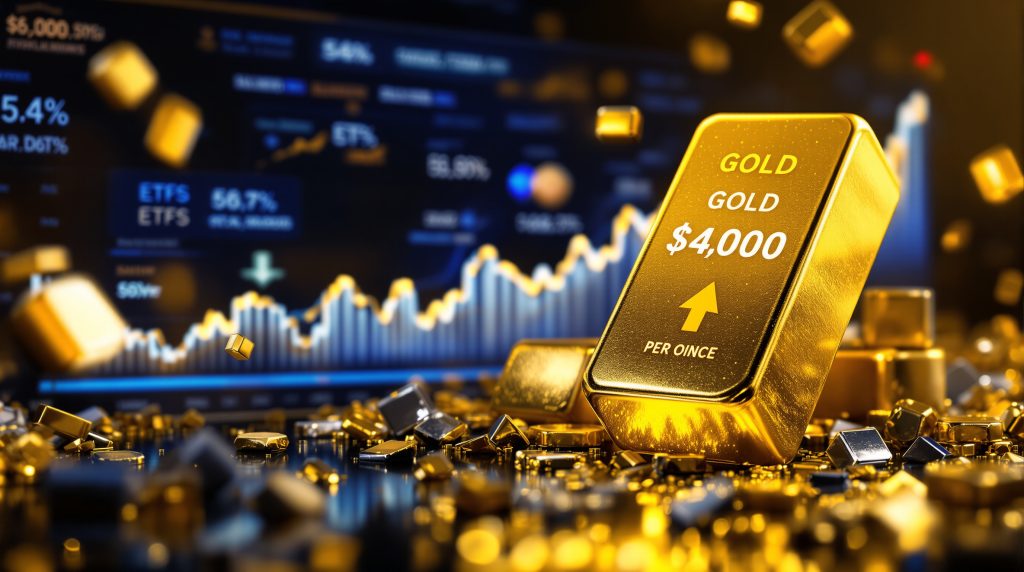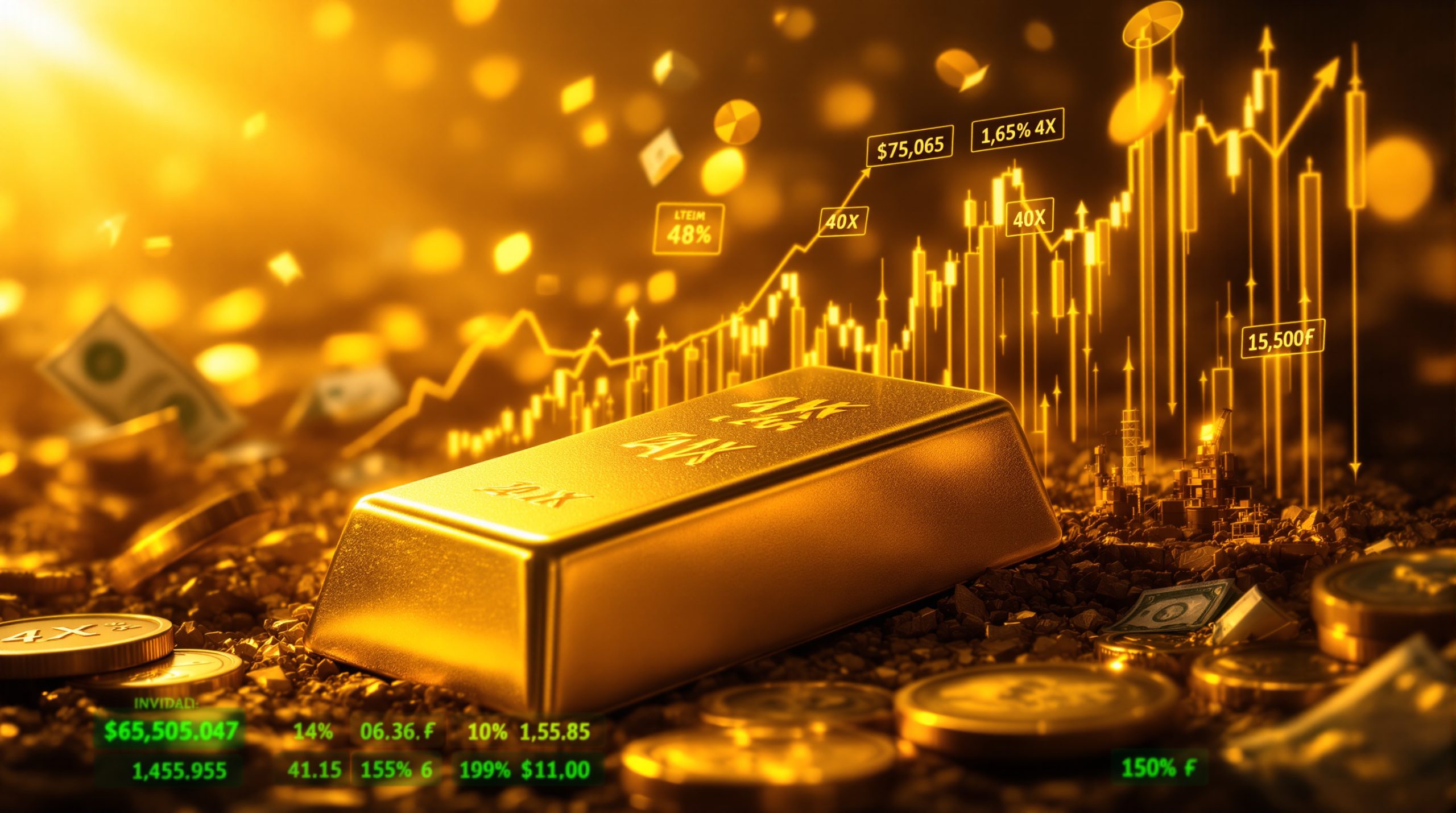Gold Takes a Breather: What's Next After the Historic $4,000 Milestone?
Gold has taken a momentary pause in its extraordinary rally, stepping back slightly after surpassing the historic $4,000 per ounce milestone for the first time. This brief retreat represents a natural consolidation phase following gold's meteoric rise, as investors lock in profits while reassessing market conditions.
The precious metal reached an unprecedented peak of $4,059.05 before experiencing a modest decline to $4,029.86 per ounce. Despite this temporary pullback, market analysts remain bullish on gold's long-term prospects, citing persistent economic uncertainties and geopolitical tensions that continue to drive safe-haven market dynamics.
Why Is Gold Pulling Back After Its Record Run?
Gold's current consolidation follows an exceptional performance period that saw the metal climb approximately 54% year-to-date. This correction appears to be a healthy breather in what has otherwise been a remarkable uptrend, allowing the market to reset before potentially continuing higher.
"What we're witnessing is a classic profit-taking scenario after reaching a significant psychological milestone," explains veteran commodities analyst Marcus Reynolds. "Investors who rode the rally from $3,500 are understandably securing some gains, but the fundamental drivers supporting gold haven't changed."
Technical indicators had been signaling overbought conditions in recent weeks, with momentum oscillators reaching extreme levels that historically precede temporary pullbacks. This technical setup, combined with the achievement of the $4,000 psychological barrier, created natural conditions for a short-term consolidation.
What Factors Propelled Gold to Its Record-Breaking Performance?
Geopolitical Tensions Creating Safe-Haven Demand
Recent diplomatic breakthroughs in Middle East peace negotiations have provided some market relief, but broader geopolitical instability continues to support gold prices. Political turmoil across major economies including Japan and France has contributed to market anxiety, while ongoing government fiscal challenges in several countries have further intensified investor concerns about economic stability.
These combined factors have triggered a significant flight to safety, with gold being the primary beneficiary as investors seek protection against potential market disruptions and currency devaluations.
"Gold thrives in uncertainty, and the current global landscape offers plenty of that," notes international relations expert Dr. Eliza Hartmann. "While localized conflicts may see temporary resolutions, the broader geopolitical framework remains fragile, keeping risk-averse capital flowing toward precious metals."
Central Bank Purchasing Reaching Historic Levels
Central banks worldwide have dramatically increased their gold reserves, continuing a trend that began several years ago. This institutional buying represents a fundamental shift in global reserve management strategies, with central banks diversifying away from traditional currency holdings.
The scale of central bank purchases has created substantial baseline demand that helps establish price floors during market corrections, providing additional confidence for private investors.
Central banks have been on pace to acquire more gold than at any time in recent decades, with purchases from emerging market economies being particularly notable. This institutional demand reflects growing concerns about currency stability and the search for assets that can preserve value through economic turbulence.
Exchange-Traded Fund (ETF) Investment Resurgence
After several years of outflows, gold-backed ETFs have experienced a remarkable resurgence. Institutional and retail investors alike have poured capital into these investment vehicles, seeking exposure to gold's price surge performance while avoiding the complexities of physical ownership.
This ETF demand has created a powerful secondary market force that amplifies price movements, particularly during periods of economic uncertainty when investment inflows accelerate.
According to industry data, gold ETFs have seen net inflows for six consecutive months, reversing a previous trend of declining holdings. This shift in investor sentiment has provided crucial support for gold prices, with each $1 billion of inflows typically associated with approximately $15-20 in price appreciation.
How Are Interest Rate Expectations Influencing Gold's Trajectory?
Federal Reserve Policy Outlook
Minutes from the Federal Reserve's recent meeting revealed growing concerns about labor market conditions, with officials acknowledging that risks were sufficient to warrant interest rate reductions. However, persistent inflation continues to complicate the Fed's policy decisions, creating a delicate balancing act.
Market participants are currently pricing in a high probability of continued rate cuts in coming months. These expectations for lower interest rates provide significant support for gold prices, as the opportunity cost of holding non-yielding assets decreases in lower-rate environments.
"The relationship between gold and interest rates is fundamental to understanding price movements," explains financial economist Dr. Patricia Kline. "When real rates are negative or falling, gold typically outperforms as investors seek alternatives to yield-bearing assets that may not keep pace with inflation."
Global Monetary Policy Coordination
Beyond the Federal Reserve, central banks globally are navigating similar challenges between supporting economic growth and controlling inflation. This worldwide trend toward monetary accommodation creates a favorable backdrop for gold, which historically outperforms during periods of coordinated global easing.
The potential for divergent policy paths among major central banks also introduces currency volatility, further enhancing gold's appeal as a stable store of value independent of any single nation's monetary policy.
Analysts point to widening interest rate differentials between major economies as a source of increased currency volatility, which typically benefits gold as investors seek stability outside traditional foreign exchange markets.
What's Happening With Other Precious Metals?
Silver's Parallel Record Run
Silver has mirrored gold's impressive performance, recently touching an all-time high of $49.57 before settling at $49.06 per ounce. The silver market continues to benefit from both investment demand and industrial applications, particularly in renewable energy technologies and electronics.
The gold-to-silver ratio has compressed significantly during this rally, suggesting strong fundamental support for silver's valuation relative to its historical relationship with gold.
"Silver's dual nature as both an industrial metal and investment asset creates unique price dynamics," notes metals specialist Dr. Jonathan Miller. "The current ratio of approximately 82:1 suggests silver may have further room to outperform gold if industrial demand continues to strengthen alongside investment flows."
Platinum Group Metals Performance
Platinum has experienced more moderate gains compared to gold and silver, recently trading at $1,653.52 after a slight decline. Meanwhile, palladium has shown resilience with a modest increase to $1,465.73.
The platinum group metals market remains heavily influenced by automotive demand, with evolving vehicle emission standards and the transition toward electric vehicles creating a complex demand outlook that differs from the primarily investment-driven gold and silver markets.
Industry analysts note that platinum's relatively subdued performance may create value opportunities if automotive demand stabilizes, particularly given its historical premium to gold that has now inverted to a significant discount.
What Technical Indicators Are Suggesting About Gold's Next Move?
Overbought Conditions and Profit-Taking
Technical analysts note that gold's rapid ascent has pushed momentum indicators into significantly overbought territory, creating conditions ripe for a short-term correction or consolidation phase. The Relative Strength Index (RSI) for gold futures has reached levels that historically precede temporary pullbacks.
However, strong fundamental support suggests that any corrections may be relatively shallow and short-lived compared to previous market cycles.
Technical analyst Morgan Williams observes: "While momentum indicators signal potential exhaustion in the short term, the underlying trend remains powerfully bullish. Previous gold bull markets have seen multiple 5-8% corrections within broader uptrends, often creating entry points for investors who missed earlier moves."
Key Support and Resistance Levels
Traders are closely monitoring the psychologically important $4,000 level as a critical support zone. A sustained break below this threshold could trigger additional technical selling toward the $3,950 area.
On the upside, the recent all-time high of $4,059.05 represents the immediate resistance, with limited historical price action above this level to establish further technical barriers.
Market technicians have identified several key technical levels to watch:
| Level | Significance |
|---|---|
| $4,059 | Recent all-time high and immediate resistance |
| $4,000 | Psychological support and recent consolidation base |
| $3,950 | Secondary support from previous resistance |
| $3,850 | Major support from prior breakout level |
| $4,100 | Projected resistance based on Fibonacci extensions |
What Should Investors Consider About Gold's Long-Term Outlook?
Portfolio Allocation Strategies
Financial advisors increasingly recommend maintaining gold exposure as a strategic investment insights rather than attempting to time short-term price movements. The optimal allocation varies based on individual risk tolerance and investment objectives, but many professionals suggest a 5-10% position as a starting point.
This approach acknowledges gold's role as both a diversification tool and a potential hedge against specific economic scenarios, including persistent inflation or currency debasement.
"The question isn't whether gold belongs in a portfolio, but rather how much," suggests wealth management advisor Rebecca Chen. "A strategic allocation of 5-10% provides meaningful diversification benefits without overly concentrating risk, especially during periods of market stress when correlations between traditional assets often increase."
Physical vs. Financial Gold Investments
Investors have numerous options for gaining gold exposure, each with distinct advantages and considerations:
-
Physical gold (coins and bars): Provides direct ownership but requires secure storage and typically involves higher transaction costs.
-
Gold ETFs and funds: Offers convenient exchange-traded exposure without physical storage concerns.
-
Mining stocks: Provides leveraged exposure to gold prices but introduces company-specific operational risks.
-
Futures and options: Enables sophisticated strategies but involves higher complexity and potential leverage risks.
The appropriate vehicle depends on investment goals, time horizon, and comfort with different risk profiles.
For investors considering physical gold, industry experts recommend focusing on widely recognized products with high liquidity, such as sovereign coins (American Eagles, Canadian Maple Leafs) or standard-weight bars from LBMA-approved refiners to maximize resale potential and minimize premium costs.
FAQs About Gold's Recent Performance
Why has gold risen so dramatically recently?
Gold's surge reflects a perfect storm of favorable conditions: persistent inflation concerns, geopolitical tensions, expectations for lower interest rates, strong central bank buying, and resurgent ETF demand. These factors have combined to create both investment and inflation hedge highs simultaneously.
Is gold overvalued at current prices?
Traditional valuation metrics for gold are less straightforward than for assets like stocks or real estate. However, when adjusted for inflation and compared to historical crisis periods, current prices reflect significant but not unprecedented premiums. The sustainability of these levels depends largely on the persistence of current economic and geopolitical uncertainties.
How might central bank policies affect gold in the coming months?
Central bank decisions, particularly from the Federal Reserve, will remain critical price drivers. Further interest rate cuts would likely support gold prices by reducing the opportunity cost of holding non-yielding assets, while any unexpected policy tightening could trigger corrections.
What role does gold play in a diversified investment portfolio?
Gold serves multiple functions in a balanced portfolio: inflation hedge, currency debasement protection, crisis insurance, and diversification from traditional financial assets. Its historically low correlation with stocks and bonds can improve risk-adjusted returns across different economic scenarios.
Further Exploration
Readers interested in learning more about gold market dynamics can also explore related educational content on mineral economics, precious metals investment strategies, and historical performance during various economic cycles. For a deeper understanding of gold's current trajectory, check out the latest record high analysis and Reuters' report on global anxieties propelling gold's record run.
Disclaimer: This article is for informational purposes only and does not constitute investment advice. Gold prices are subject to significant volatility, and past performance does not guarantee future results. Investors should conduct their own research or consult with financial professionals before making investment decisions.
Looking for Early Warning on the Next Major Gold Discovery?
Receive instant alerts on significant ASX gold discoveries with Discovery Alert's proprietary Discovery IQ model, transforming complex geological data into actionable investment opportunities before the broader market reacts. Explore historic examples of exceptional returns from major discoveries on our dedicated discoveries page and position yourself ahead of the market.




